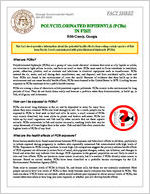Georgia Environmental Health 404-657-6534
FACT SHEET
POLYCHLORINATED BIPHENYLS (PCBs) IN FISH
Bibb County, Georgia
This fact sheet provides information about the potential health effects from eating certain species of fish from Rocky Creek contaminated with polychlorinated biphenyls (PCBs).
What are PCBs?
Polychlorinated biphenyls (PCBs) are a group of man-made chemical mixtures that exist as oily liquids or solids, are colorless to light yellow in color, and have no smell or taste. PCBs were used as flame retardants in insulation, paints, adhesives, plastics, and as coolants and lubricants in electrical equipment such as transformers. PCBs entered the air, water, and soil during their manufacture, use, and disposal; and from accidental spills, leaks and fires. PCBs are found in the environment all over the world. Because of evidence that they build up in the environment and can cause harmful health effects, PCBs were banned in the United States in 1979. Limiting human exposure to PCBs continues to be a public health concern.
PCBs are among a class of chemicals called persistent organic pollutants. PCBs remain in the environment for long periods of time. They do not break down easily and become a problem when they bioaccumulate, or build up, in fish, wild game, and in humans.
How can I be exposed to PCBs?
PCBs can travel long distances in the air and be deposited in areas far away from where they were released. PCBs also bind strongly to soil. As a result, people can be exposed to PCBs in food such as beef and milk. In water, a small amount of PCBs may remain dissolved, but most sticks to plants and bottom sediments. PCBs are taken up by small organisms and fish and by other animals that eat these aquatic animals. PCBs accumulate in fish and marine mammals, reaching levels that may be many thousands of times higher than in the water. Fish and shellfish often contain the highest levels of PCBs of any food.
What are the health effects of PCB exposure?
Some human studies have found associations between PCB exposure and behavioral effects in children, particularly in infants exposed during pregnancy in mothers who repeatedly consumed fish contaminated with high levels of PCBs. Exposures to PCBs among workers in some high risk occupations suggest the primary adverse health effects of PCB exposure are chloracne (a severe form of acne), skin pigment changes, rashes, eye irritation, and changes in blood and urine that may indicate liver damage. PCB exposures in the general population are not likely to result in skin and liver effects. PCBs are known to cause cancer in animals, but it is unclear if PCBs directly cause cancer in humans. Based on animal studies, PCBs have been classified as a probable human carcinogen by the U.S. Environmental Protection Agency (EPA).
Tests exist to measure levels of PCBs in blood, fat, and breast milk, but these are not routinely conducted. Most people normally have low levels of PCBs in their body because nearly everyone has been exposed to PCBs. The tests can show if PCB levels are elevated, which would indicate past exposure to above-normal levels of PCBs, but cannot determine when or how long you were exposed, or whether you will develop health effects.
Can I be exposed to PCBs from eating fish from Rocky Creek?
PCB advisory sign near Rocky Creek
Armstrong World Industries, Incorporated, in south Macon was added to EPA's "Superfund" National Priorities List for release of PCBs and other contaminants to soil and sediment. Elevated levels of PCBs were found in on-site landfills, drainage pathways, and Rocky Creek. During the late 1990's, fish tissue analyses was conducted for a variety of species caught in Rocky Creek and the Ocmulgee River several miles downstream of the Armstrong site. Results indicate that if residents regularly eat fish caught in Rocky Creek at locations south and southeast of the Armstrong site sources, the calculated exposure dose for adult recreational anglers can be up to 23 times higher than the health effects guidance value, and the calculated exposure dose for a child eating half the adult amount can be up to 50 times higher than the health value. Individuals who ate, or are currently eating fish caught in Rocky Creek south and southeast of the Armstrong site could have been and could be currently exposed to PCBs at levels that could harm their health.
Can I eat fish from Rocky Creek or the Ocmulgee River?
The City of Macon issued a fish advisory for Rocky Creek (`PCBs Present--Fish at Your Own Risk'). The Georgia Environmental Protection Division publishes fish consumption guidelines for the Ocmulgee River (limit of one meal per month for catfish) to reduce exposure to PCBs.
What can I do to protect myself from chemicals found in fish?
1) Eat a variety of fish and seafood
2) Avoid eating fish and seafood known to have high levels of contamination
3) Find safer ways to prepare fish and seafood
4) Before cooking, remove organs, skin and fat as shown in the diagram below
5) Cook the fish in a way that the fat can drip away from the fish, such as grilling
6) Avoid breading and deep frying fish which causes the fat to be absorbed into the breading.
FOR MORE INFORMATION
Georgia Department of Public Health Chemical Hazards Program (404) 657-6534
www.health.state.ga.us/programs/hazards
OTHER RESOURCES U.S. Environmental Protection Agency
www.epa.gov/epawaste/hazard/tsd/pcbs
Agency for Toxic Substances and Disease Registry
www.atsdr.cdc.gov/substances
pxn:2/7/12
